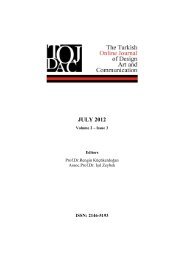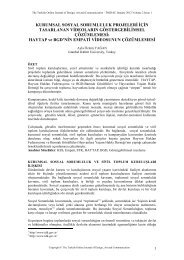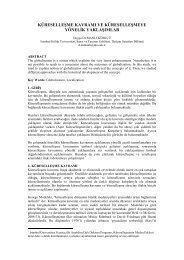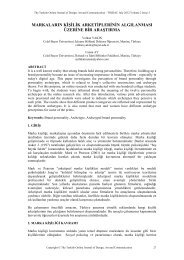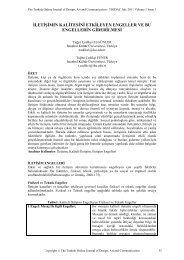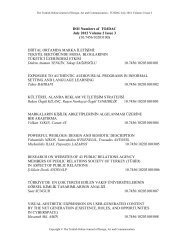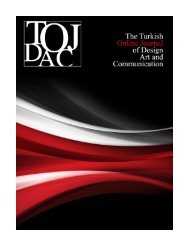aprıl 2012 - tojdac.org
aprıl 2012 - tojdac.org
aprıl 2012 - tojdac.org
Create successful ePaper yourself
Turn your PDF publications into a flip-book with our unique Google optimized e-Paper software.
The Turkish Online Journal of Design, Art and Communication - TOJDAC April <strong>2012</strong> Volume 2 Issue 2<br />
temporal, spatial, interactive – are similarly represented as sets of variables that can change<br />
continuously. Manovich emphasizes this new logic of form is deeply encoded in the interfaces<br />
of software packages and the tools they provide. Those interfaces quickly led to a new<br />
aesthetics: the continuous transformations of all image elements and often the image as a<br />
whole. [10]<br />
The understanding of interface are also changing in hybrid media. Rather than controling the<br />
graphical images with buttons such as play rewind and pause, O’Neill states that we should<br />
also see hybrid multimedia applications in their own right. Just as the logic of the printed page<br />
still dominates how we lay out our interactive screens, the logic of film still dominates how<br />
we deal with moving images at the interface. Shots, pace, angle and narrative structure have<br />
never been more important to understand the moving image as they are in interactive media<br />
today. [12]<br />
Manovich explains that although a particular software application does not directly prescribe<br />
to its users what they can and cannot do, the structure of the interface strongly influences the<br />
designer’s thinking. [10]<br />
6. SOUND IN HYBRID MEDIA<br />
Sound is a very basic design tool when considered in motion graphics. According to Strizver<br />
the incorporation of sound with motion graphics gives it another dimension, so to speak. The<br />
addition of music, voice and the spoken word, as well as other sound effects, adds a very<br />
powerful, emotional element that can go a long way toward the setting of the mood,<br />
conveying a message, as well as drawing attention to and emphasizing or reinforcing a<br />
particular frame or segment. [15]<br />
Sound is no longer a supporting tool to emphasize the meaning and expression of the images.<br />
Instead, sound is directly used as the source for creating the visuals. With the help of design<br />
softwares the data such as frequency or loops which obtained from the sound can be<br />
transformed into highly aesthetic visual solutions and now the roles between sound and<br />
images have changed dramatically. One of the most common examples of software for sound<br />
visualization is the one used in media players. But sound in hybrid media is much more than<br />
what we see in media players. Lexmann explains the relationship of sound with visuals is<br />
based on a temporal and spatial concept while the “film space” enforces the impression of a<br />
space outside the projection scope in which the spectators seemingly find themselves,<br />
nowadays it may be termed the “visual space” taking into consideration the broader context of<br />
the audiovisual expression. [7]<br />
Figure 6. Piano Cubes by Max-Heinrich Müller. Music Visualization of Frederic Chopin’s<br />
Ballade No.1<br />
Copyright © The Turkish Online Journal of Design, Art and Communication 105



